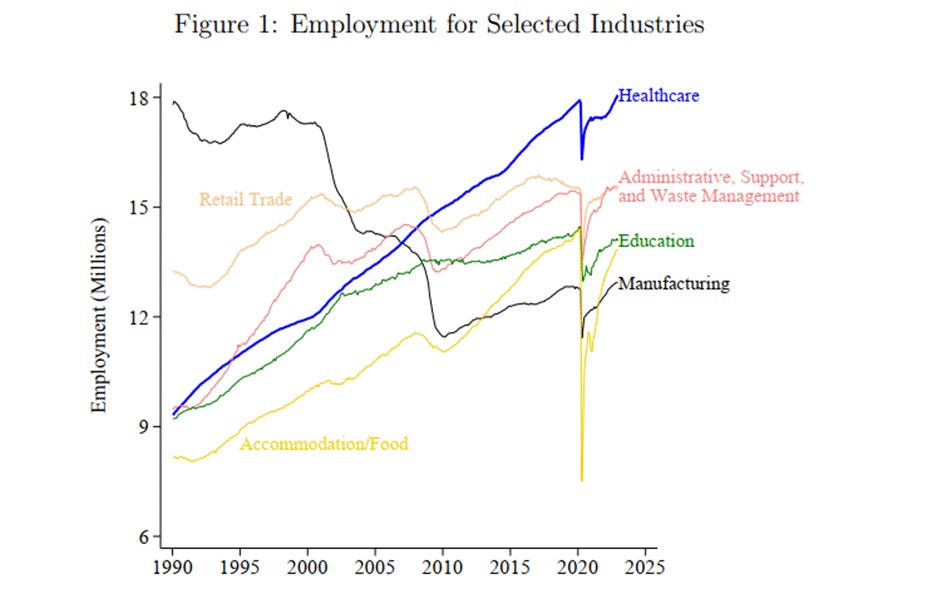Summary: Health care employment and wages increased dramatically since 1980, although health care employment did not replace lost manufacturing jobs.
Source: Gottlieb, et al National Bureau of Economic Research, March, 2025
Health care employment has risen twice as fast as the rest of the economy since 1980, and health care salaries also increased substantially more than wages in other industries, according to a new report published as a preprint (not yet peer reviewed) by the National Bureau of Economic Research. The researchers used data from the Census Bureau and the Health Resources Services Administration.
They found that the number of advanced practice clinicians (APCs, nurse practitioners and physician assistants, called “midlevels” by the researchers) doubled from 2010 to 2022, and now exceeds 500,000. They estimate that more than half of all primary care is provided by APCs. The average health care worker made 4% less than the average worker outside of health care in 1980, but 14% more in 2022. Women have been about three-quarters of the health care workforce since 1980, but the researchers report convergence of men and women’s occupations in health care, with more female physicians and more male nurses.
Source: Gottlieb, et al National Bureau of Economic Research, March, 2025
Some have suggested that health care is the new “economic engine” that can replace manufacturing as a source of good middle-class wages. However, the researchers did not find evidence of growth of significantly more health care positions in communities that lost more manufacturing jobs. Health care jobs offset more manufacturing job losses for women and those with a college education. Wage growth has been less polarized in health care than in the rest of the economy, with a smaller portion of the total increase in wages going to those in the top 10% of total income.
This research also shows that foreign-born physicians make up a large share of physicians (28.4% in 2022), but foreign-born nurses make up a small share of nurses (12.3%, nearly one-third less than the economy-wide average).
Earnings Growth, 1980-2022
Source: Gottlieb, et al National Bureau of Economic Research, March, 2025. *Advanced practice clinicians (midlevels) were only tracked beginning in 2010.
Implications for employers:
Strong increases in health employment and wages of those in health care help explain the growth of health care to almost 18% of the total economy.
Advanced practice clinicians can help address the shortage of primary care physicians, although APCs are increasingly choosing to go into specialties.
Hospitals and health care systems are the largest employer in many communities and have substantial political power to resist regulations that could lower health care cost increases.
This study period does not include recent cuts in National Institute of Health and other federal research funds, and substantial future cuts in Medicaid or other federal health care programs that could lead to loss of employment in the health care industry.
Thanks for reading. You can find previous posts in the Employer Coverage archive
Please subscribe, “like” share this newsletter with friends and colleagues. Thanks!
Tomorrow: Primary care recovers (a little) in national residency match





